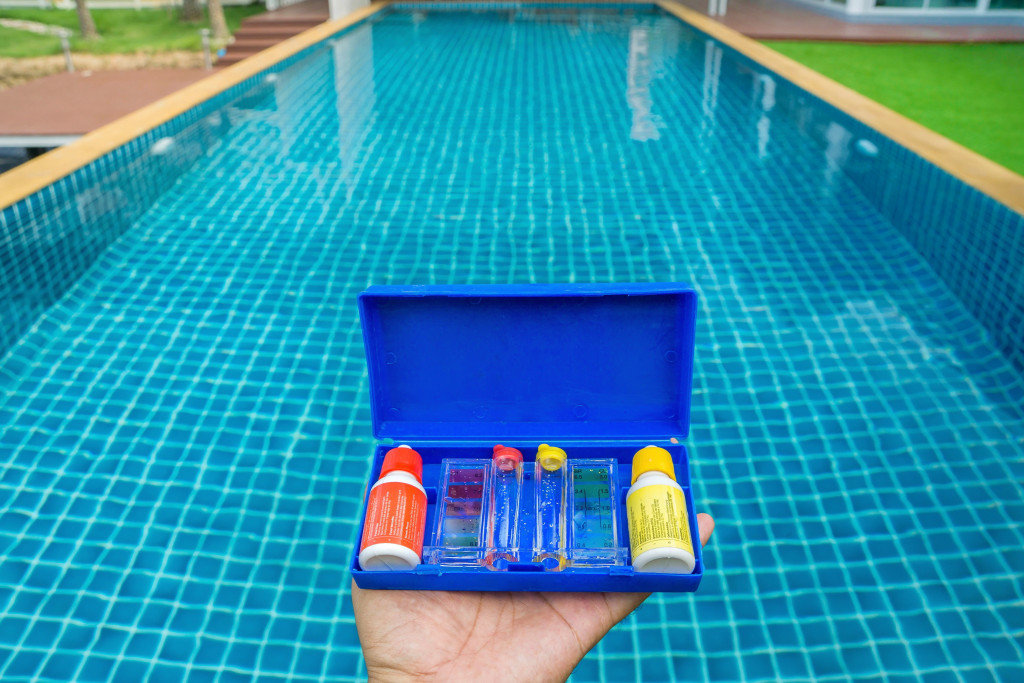Many don’t realize the amount of work, precision, and science in maintaining a pool. Keeping it under healthy and ideal conditions requires patience and consistency. It’s an important job, too, since the consequences can be harmful to the swimmers’ health. Another consequence is the growth of algae. That’s right; pools can grow algae, too.
Here are the types of algae commonly observed in neglected pools.
Types of Algae
Three types of algae can be observed in a pool: green algae, yellow algae, and black algae. Either or all may be found in a pool, but the one pool owners should be more worried about is black algae. Of all the algae, black algae are most resistant to chemical treatment. Pour an algaecide directly into affected areas and brush it off with a stuffed brush. On the other hand, the most common and weakest to withstand chemical treatment is green algae. Yellow algae is a little more resilient and cling more tightly than green algae. Similar to black algae, both should be treated with some algaecide and a little brushing.
Although a pool with some algae isn’t enough to get swimmers to feel ill, the bacteria that the algae house is harmful. By adding algaecide, you’re not just getting rid of the algae but regulating pH levels, too.
What Happens to a Pool When It’s Filled With Algae?
Algae is the last thing you want growing in your pool. Here are some of its effects after being present in pool water to give you a picture of what that’s like.
-
Cloudy Water
One look at a cloudy swimming pool, and it’s enough for anybody to hesitate. Other than being unsightly, it’s a concerning sight. The cloudy appearance and a slight color change should be a telltale sign of algae in a pool. Other than the gray water, it is most likely home to illness-causing bacteria too. This picture is too far off from sparkling, clean, and inviting pool water.
-
Low Chlorine Levels
If there is a presence of algae in the water, the chlorine levels are low or inconsistent. But at the same time, algae also demand chlorine in the water, making it a vicious cycle. To combat this, ensure that chlorine levels are always consistent and at least two ppm in the water.

-
Not Healthy for Swimming
Because of the bacteria present in the water, this is not an ideal environment for children, the elderly, and individuals with compromised immune systems. But generally, it’s not a healthy environment for anybody to expose themselves to. The algae is a telltale sign of bacterial presence in the water. This may cause skin infections, irritation, and rashes in swimmers.
-
Affects Pumps and Pathways
Too much algae growth can clog up filters and decrease sanitation equipment effectiveness. This can also contribute to the cloudy appearance of the water. The less effective the sanitation equipment, the more algae may grow in the water. The more algae in the water, the more algae-feeding bacteria are present.
How to Prevent Algae Growth in Your Pool
Contaminated swimsuits and rain can cause algae spores to get into your pool, but you can prevent them from forming colonies through proper filtration and sanitation. Here are some ways to avert algal blooms in your pool.
-
Proper Water Treatment
Chlorine is an excellent “shock” for algae. It’s inexpensive, works rapidly, and doesn’t damage the tiles. If the residue is a concern, that shouldn’t worry you. It usually degrades in one to two days and turns into normal water. Direct sunlight for a couple of hours also helps reduce chlorine levels up to 90%. This should be done once w week. Additionally, lower the pH level to 7.2 to 7.6 to kill off bacteria, algae, and prevent eye irritation. Be sure to check both chlorine and pH levels at least twice a day or more if the pool is used often.
-
Algaecide Once a Week
As mentioned above, algaecide is effective in getting rid of algae. There are different kinds of algaecides, depending on the type that you’re dealing with. If done correctly and regularly, it’ll help keep your pool algae-free.
-
Remove Phosphate Regularly
From dead leaves and other debris to human sweat and oils, phosphate is present. This is why it’s inevitable for it to be present in your pool. Phosphate is what keeps algae and spores nourished and thriving in the water. Test your pool for phosphate and treat it with a phosphate remover of your choice.
Conclusion
Keeping pool water clean and sparkling has less to do with its looks and more to do with keeping it a safe space for swimmers. Owning a pool is an investment and a way to have a fun time at home, but it’s also a responsibility.
